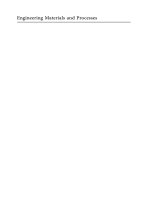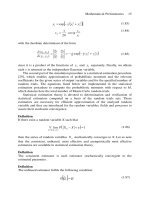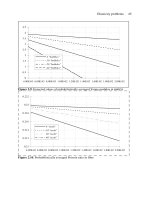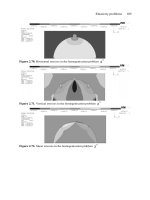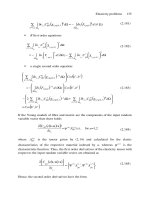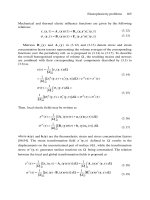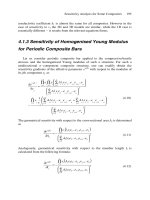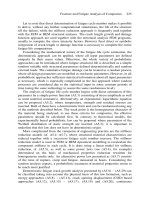The Behavior of Structures Composed of Composite Materials Part 1 doc
Bạn đang xem bản rút gọn của tài liệu. Xem và tải ngay bản đầy đủ của tài liệu tại đây (1.67 MB, 30 trang )
The Behavior of Structures Composed of Composite Materials
SOLID MECHANICS AND ITS APPLICATIONS
Volume 105
Series Editor: G.M.L. GLADWELL
Department of Civil Engineering
University of Waterloo
Waterloo, Ontario, Canada N2L 3GI
Aims and Scope of the Series
The fundamental questions arising in mechanics are: Why?, How?, and How much?
The aim of this series is to provide lucid accounts written by authoritative researchers
giving vision and insight in answering these questions on the subject of mechanics as it
relates to solids.
The scope of the series covers the entire spectrum of solid mechanics. Thus it includes
the foundation of mechanics; variational formulations; computational mechanics;
statics, kinematics and dynamics of rigid and elastic bodies: vibrations of solids and
structures; dynamical systems and chaos; the theories of elasticity, plasticity and
viscoelasticity; composite materials; rods, beams, shells and membranes; structural
control and stability; soils, rocks and geomechanics; fracture; tribology; experimental
mechanics; biomechanics and machine design.
The median level of presentation is the first year graduate student. Some texts are mono-
graphs defining the current state of the field; others are accessible to final year under-
graduates; but essentially the emphasis is on readability and clarity.
For a list of related mechanics titles, see final pages.
The Behavior of
Structures Composed of
Composite Materials
Second Edition
by
JACK R. VINSON
H. Fletcher Brown Porfessor of Mechanical & Aerospace Engineering,
The Center for Composite Materials and The College of Marine Studies,
Department of Mechanical Engineering,
University of Delaware,
Newark, Delaware, U.S.A.
and
ROBERT L. SIERAKOWSKI
Chief Scientist,
AFRL/MN Eglin AFB,
Florida, U.S.A.
KLUWER ACADEMIC PUBLISHERS
NEW YORK, BOSTON, DORDRECHT, LONDON, MOSCOW
eBook ISBN: 0-306-48414-5
Print ISBN: 1-4020-0904-6
©2004 Kluwer Academic Publishers
New York, Boston, Dordrecht, London, Moscow
Print ©2002 Kluwer Academic Publishers
All rights reserved
No part of this eBook may be reproduced or transmitted in any form or by any means, electronic,
mechanical, recording, or otherwise, without written consent from the Publisher
Created in the United States of America
Visit Kluwer Online at:
and Kluwer's eBookstore at:
Dordrecht
To my beautiful wife, Midge, for providing the wonderful environment, love, patience
and encouragement to complete this text - JRV
In loving memory of Nina, and also to my wonderful children, Sandy and Steve - RLS
Preface to the Second Edition
The purpose of this text is to educate the engineering reader in the various aspects
of mechanics for using composite materials in the design and analysis of composite
structures and products.
In Chapter 1, the text acquaints the reader with the description of a composite
material, and its constituents. Then, methods by which to manufacture composite
materials are discussed, followed by a description of the uses of composite materials
early in the twenty-first century.
Chapter 2 provides the fundamentals of anisotropic elasticity, and the methods to
characterize and mathematically describe composite laminae and laminates which are the
“building blocks” of composite structures. Also discussed are thermal, hygrothermal,
high strain rate and piezoelectric considerations in modern composites.
Chapter 3 then deals exclusively with the static and dynamic response of
composite plates and panels subjected to a variety of mechanical and environmental loads
in great detail. This includes stresses, deformations, buckling loads, natural frequencies
and response to blast loads. Chapter 4 analogously treats a special case of the above,
namely beams, columns and rods.
In Chapter 5, cylindrical composite shells are discussed, both in determining the
stresses and deformations due to static loads, but in treating the buckling of these shells
under various loads and their combinations. The peculiar behavior of shells, (such as the
bending boundary layer) compared to plates and beams is discussed in
detail.
Because so many practical structural problems are too difficult or complex to
obtain analytical solutions, Chapter 6 provides in-depth knowledge of attacking real life
structural design problems using energy principles and variational methods. Thus, the
engineer can always obtain a solution to a problem.
Chapter 7 provides various strength and failure theories widely used today, and
their comparison. Chapter 8 provides suggested ways to analyze and design adhesive
bonded joints and mechanically fastened joints.
Chapter 9 has been added to provide a needed introduction to composite design
philosophy.
Appendix 1 provides a discussion of micromechanics basics; Appendix 2 lists all
or most of the test standards for polymer matrix composite and Appendix 3 lists the
mechanical properties of many composite in use today.
At the end of each chapter are numerous problems, which can be useful as
homework problems or modified for examination problems. Professors may contact the
authors for solutions to these problems.
Appreciation is hereby expressed to James T. Arters, an engineering student at the
University of Delaware, who meticulously typed the text through its evolution. His
accuracy, stamina and diligence are greatly appreciated. Appreciation is also expressed
to Dr. Gregg Schoeppner for his contributions to Chapter 1 and the Appendices, and to
Ms. Jill O’Donnell for her manuscript reading.
Jack R. Vinson
Robert L. Sierakowski
Preface to the First Edition
While currently available tests dealing with the subject of high performance
composite materials touch upon a spectra of topics such as mechanical metallurgy,
physical metallurgy, micromechanics and macromechanics of such systems, it is the
specific purpose of this text to examine elements of the mechanics of structural
components composed of composite materials. This text is intended for use in training
engineers in this new technology and rational thought processes necessary to develop a
better understanding of the behavior of such material systems for use as structural
components. The concepts are further exploited in terms of the structural format and
development to which the book is dedicated. To this end the development progresses
systematically by first introducing the notion and concepts of what these new material
classes are, the fabrication processes involved and their unique features relative to
conventional monolithic materials. Such introductory remarks, while far too short in
texts of this type, appear necessary as a precursor for engineers to develop a better
understanding for design purposes of both the threshold limits to which the properties of
such systems can be pushed a swell as the practical limitations on their manufacture.
Following these introductory remarks, an in-depth discussion of the important
differences between composites and conventional monolithic material types is discussed
in terms of developing the concepts associated with directional material properties. That
is, the ideas of anisotropic elasticity for initially homogeneous bodies in the
phenomenological sense are described and presented. The use of such analytical tools is
then presented through exemplification of selected problems for a number of classical
type problems of various geometric shapes including plane stress, plane strain and the
bending of a simply supported beam.
These ideas are carried forward and developed for continuous fiber composites in
Chapter Two which discusses both single ply laminae and multi-ply laminate theory.
This is then followed by a series of chapters, each of which deals with functional aspect
of structural design in which the basic building blocks of a structural system are made.
That is, plates and panels; beams, columns and rods; and cylindrical and spherical shells
are each discussed within the framework of their potential use in a functional
environment. Thus the traditional topics of conventional monolithic (isotropic) material
structural elements such as structures subjected to static loads, thermal and other
environmental loads, structural instability and vibratory response are included along with
chapters on energy methods and failure theories of composite materials.
Energy methods have been included to present a tool for solving difficult
problems of various types encountered in practice. Indeed, in many instances closed
form solutions are not possible and approximate solutions must be sought. Energy
methods thus provide both an alternative for the formulation of such problems plus a
means of generating approximate solutions.
The chapter on failure theories is a generic presentation in the senses that any
and/or all of the above structural components consisting of various multi-ply construction
can fail when subjected to a sufficiently large loading combination. It is emphasized that
the failure of composites is a complicated, changing issue because of the diverse ways in
which such structural systems can fail due both to the geometric ply arrangement of the
X
components, complicated load paths, and the diversity of failure mechanisms which can
be activated. Therefore, this chapter should serve in a global sense at best as a guide to
the prediction of structural integrity, while more common and acceptable
phenomenological failure theories are being developed.
Finally, a chapter on joining is included to discuss to some detail the two methods
by which composite material structural components can be joined: namely, adhesive
bonding and mechanical fastening. Again, the material presented is an introduction to the
subject which is rapidly changing and developing.
At the end of each chapter are several problems, characteristic of the material
covered which can be used. Some answers are given in an appendix.
Knowing that nothing is perfect, the authors welcome any notification of errors
and ambiguities, and if addresses are provided, authors will forward errata sheets
periodically.
Appreciation is hereby expressed to many students at the University of Delaware,
University of Florida, Ohio State University, The Ballistics Research Laboratory, and the
Argentine Air Force who have helped directly or indirectly in refining, improving and
correcting the text, as well as working various problems and examples. In addition
appreciation is expressed to Dr. W.J. Renton, Vought Corporation, who has used portions
of the text at the University of Texas-Arlington, and made suggestions and corrections.
Jack R. Vinson
Robert L. Sierakowski
Contents
Preface to the Second Edition
VII
Preface to the First Edition
IX
1.
Introduction to Composite Materials
1
1
2
6
8
11
21
33
36
36
37
39
39
40
46
50
53
57
58
59
66
76
77
79
87
87
87
91
94
95
98
102
1.1.
1.2.
1.3.
1.4.
1.5.
1.6.
1.7.
1.8.
1.9.
1.10.
General History
Composite Material Description
Types of Composite Materials
Constituent Properties
Composite Manufacturing, Fabrication and Processing
Uses of Composite Materials
Design and Analyses with Composite Materials
References
Journals
Problems
2.
Anisotropic Elasticity and Composite Laminate Theory
2.1.
2.2.
2.3.
2.4.
2.5.
2.6.
2.7.
2.8.
2.9.
Introduction
Derivation of the Anisotropic Elastic Stiffness and Compliance Matrices
The Physical Meaning of the Components of the Orthotropic Elasticity
Tensor
Methods to Obtain Composite Elastic Properties from Fiber and Matrix
Properties
Thermal and Hygrothermal Considerations
Time-Temperature Effects on Composite Materials
High Strain Rate Effects on Material Properties
Laminae of Composite Materials
Laminate Analyses
2.10.
2.11.
2.12.
Piezoelectric Effects
References
Problems
3.
Plates and Panels of Composite Materials
3.1.
3.2.
3.3.
3.4.
3.5.
3.6.
3.7.
Introduction
Plate Equilibrium Equations
The Bending of Composite Material Laminated Plates: Classical Theory
Classical Plate Theory Boundary Conditions
Navier Solutions for Rectangular Composite Material Plates
Navier Solution for a Uniformly Loaded Simply Supported Plate – An
Example Problem
Levy Solution for Plates of Composite Materials
XII
3.8.
3.9.
3.10.
3.11.
3.12.
3.13.
3.14.
3.15.
3.16.
3.17.
3.18.
3.19.
3.20.
3.21.
3.22.
3.23.
3.24.
3.25.
3.26.
Perturbation Solutions for the Bending of a Composite Material Plate With
Mid-Plane Symmetry and No Bending-Twisting Coupling
Quasi-Isotropic Composite Panels Subjected to a Uniform Lateral Load
A Static Analysis of Composite Material Panels Including Transverse
Shear Deformation Effects
Boundary Conditions for a Plate Using the Refined Plate Theory Which
Includes Transverse Shear Deformation
Composite Plates on an Elastic Foundation
Solutions for Plates of Composite Materials Including Transverse-Shear
Deformation Effects, Simply Supported on All Four Edges
Dynamic Effects on Panels of Composite Materials
Natural Flexural Vibrations of Rectangular Plates: Classical Theory
Natural Flexural Vibrations of Composite Material Plate Including
Transverse-Shear Deformation Effects
Forced-Vibration Response of a Composite Material Plate Subjected to a
Dynamic Lateral Load
Buckling of a Rectangular Composite Material Plate – Classical Theory
Buckling of a Composite Material Plate Including Transverse-Shear
Deformation Effects
Some Remarks on Composite Structures
Methods of Analysis for Sandwich Panels With Composite Material
Faces, and Their Structural Optimization
Governing Equations for a Composite Material Plate With Mid-Plane
Asymmetry
Governing Equations for a Composite Material Plate With Bending-
Twisting Coupling
Concluding Remarks
References
Problems and Exercises
4.
Beams, Columns and Rods of Composite Materials
4.1.
4.2.
4.3.
4.4.
4.5.
4.6.
4.7.
4.8.
4.9.
4.10.
4.11.
4.12.
4.13.
Development of Classical Beam Theory
Some Composite Beam Solutions
Composite Beams With Abrupt Changes in Geometry or Load
Solutions by Green’s Functions
Composite Beams of Continuously Varying Cross-Section
Rods
Vibration of Composite Beams
Beams With Mid-Plane Asymmetry
Advanced Beam Theory for Dynamic Loading Including Mid-Plane
Asymmetry
Advanced Beam Theory Including Transverse Shear Deformation Effects
Buckling of Composite Columns
References
Problems
106
109
111
114
115
116
119
120
122
124
130
132
135
138
138
139
140
141
143
155
155
160
165
171
173
177
179
183
184
193
197
200
200
XIII
5.
Composite Material Shells
5.1.
5.2.
5.3.
5.4.
5.5.
5.6.
5.7.
5.8.
5.9.
Introduction
Analysis of Composite Material Circular Cylindrical Shells
Some Edge Load and Particular Solutions
A General Solution for Composite Cylindrical Shells Under Axially
Symmetric Loads
Response of a Long Axi-Symmetric Laminated Composite Shell to an
Edge Displacement
Sample Solutions
Mid-Plane Asymmetric Circular Cylindrical Shells
Buckling of Circular Cylindrical Shells of Composite Materials Subjected
to Various Loads
Vibrations of Composite Shells
5.10.
5.11.
5.12.
Additional Reading On Composite Shells
References
Problems
6.
Energy Methods For Composite Material Structures
6.1.
6.2.
6.3.
6.4.
6.5.
6.6.
6.7.
6.8.
6.9.
Introduction
Theorem of Minimum Potential Energy
Analysis of a Beam Using the Theorem of Minimum Potential Energy
Use of Minimum Potential Energy for Designing a Composite Electrical
Transmission Tower
Minimum Potential Energy for Rectangular Plates
A Rectangular Composite Material Plate Subjected to Lateral and
Hygrothermal Loads
In-Plane Shear Strength Determination of Composite Materials in
Laminated Composite Panels
Use of the Theorem of Minimum Potential Energy to Determine Buckling
Loads in Composite Plates
Trial Functions for Various Boundary Conditions for Composite Material
Rectangular Plates
6.10.
6.11.
6.12.
6.13.
6.14.
6.15.
Reissner’s Variational Theorem and its Applications
Static Deformation of Moderately Thick Beams
Flexural Vibrations of Moderately Thick Beams
Flexural Natural Frequencies of a Simply Supported Beam Including
Transverse Shear Deformation and Rotatory Inertia Effects
References
Problems
7.
Strength and Failure Theories
7.1.
7.2.
7.3.
Introduction
Failure of Monolithic Isotropic Materials
Anisotropic Strength and Failure Theories
7.3.1.
7.3.2.
Maximum Stress Theory
Maximum Strain Theory
215
215
215
222
228
230
232
239
243
252
253
253
254
259
259
260
261
268
272
274
276
282
285
286
289
293
295
299
299
303
303
306
309
310
310
XIV
7.3.3.
Interactive Failure Theories
311
315
328
331
332
333
333
333
348
354
354
357
361
361
368
371
375
375
391
393
397
401
7.4.
7.5.
7.6.
7.7.
Lamina Strength Theories
Laminate Strength Analysis
References
Problems
8.
Joining of Composite Material Structures
8.1.
8.2.
8.3.
8.4.
8.5.
8.6.
General Remarks
Adhesive Bonding
Mechanical Fastening
Recommended Reading
References
Problems
9.
Introduction to Composite Design
9.1.
9.2.
9.3.
Introduction
Structural Composite Design Procedures
Engineering Analysis
Appendices
A-1
A-2
A-3
Micromechanics
Test Standards for Polymer Matrix Composites
Properties of Various Polymer Composites
Author Index
Subject Index
CHAPTER 1
INTRODUCTION TO COMPOSITE MATERIALS
1.1 General History
The combining of materials to form a new material system with enhanced
material properties is well documented in history. For example, the ancient Israelite
workers during their tenure under the Pharaohs incorporated chopped straw in bricks as a
means of enhancing their structural integrity (see Exodus 5). The Japanese Samurai
warriors were known to use laminated metals in the forging of their swords to obtain
desirable material properties. More recently, in the century civil engineers placed
steel rebars in cement and aggregate to make a well-known composite material, i.e.,
reinforced concrete. One could say that the modern era of composite materials began
with fiberglass polymer matrix composites about the time of World War II.
In order to introduce the reader to the subject matter of new high-performance
composite materials it is necessary to begin by defining precisely what constitutes such a
class of materials. Furthermore, one must also define the level or scale of material
characterization to adequately describe such systems for discussion. This is done with
the understanding that any definition and classification scheme introduced is somewhat
arbitrary.
For introductory purposes, many workers in the field of composites use a
somewhat loose description for defining a composite material as simply being the
combination of two or more materials formed to obtain some useful new material or
specific material property. In some cases the addition of the words microscopic and
macroscopic are added to describe the level of material characterization.
The definition posed above is to a large extent broad-based, in that it encompasses
any number of material systems for which different levels of characterization must be
used to specify the system and for which different analytical tools may be necessary for
modeling purposes. As a simplistic example of the definition used above we can
consider a beam consisting of clad copper and titanium material elements used in a
switching strip. Such a composite system can be considered at the macroscopic level as
providing enhanced temperature-dependent material behavior due to the mismatch in
coefficients of thermal expansion between the copper and titanium metallic elements.
This material system, while consisting of two dissimilar materials and falling within the
realm of satisfying the definition of a composite material would not be acceptable as
being representative of modern definitions of composites for current applications in the
aerospace, automotive and other technical areas. A representative list of journals dealing
with composite materials is given in Section 1.9.
2
1.2 Composite Material Description
In order that agreement may be reached at the outset on a suitable modern day
definition for advanced composite materials a structural classification according to the
use of the following typical constituent elements is tabulated below.
Of the structural types cited above, Type (III), or the Macrostructural type is the
most important for further discussion herein. Continuing with this, next consider a
further classification within the structural framework adopted. A classification of
combinations of materials is described and shown in Table 1.1.
Fiber
.
Either continuous (long or chopped whiskers) suspended in a matrix material
Particulate
.
Composed of particles suspended in a matrix material.
Flake
.
Composed of flakes which have large ratios of platform area to thickness and are
suspended in a matrix material.
3
Filled/Skeletal
.
Composed of a continuous skeletal matrix filled by a second material.
Laminar
.
Composed of layers (lamina) bonded together by a matrix material.
The fiber composite classification in Table 1.1 can be further structured for
identification by noting the direction and placement of fibers. This results in Figure 1.1
for classification of fiber-reinforced composite types.
A further classification of the woven composite configurations, shown in (b)
above, is illustrated in the geometric architectures shown below in Figure 1.2.
4
Of the composite material types described in Table 1.1, fiber composites have
received considerable attention in recent years due to the development of advanced fiber
types such as glass, Kevlar and graphite, which have moduli in excess of psi/20
GPa. The incorporation of these fiber types into suitable binders/matrices, which may be
metals, non-metals or ceramics, leads to a synergism in which the new material possesses
unique properties compared to the properties of either of the constituent elements. The
acceleration of this material’s revolution is depicted in Figure 1.3, which shows the state
a maturity of various materials and, in particular, the status of composite materials.
5
This leads to a definition of a composite material, which has been defined in
ASTM D 3878-95c as:
“Composite Material. A substance consisting of two or more materials, insoluble in
one another, which are combined to form a useful engineering material possessing
certain properties not possessed by the constituents.”
As previously discussed, the way in which the constituents of a composite
material are engineered is critical to the performance of the material system. Composites
consisting of fibers embedded in a suitable matrix (binder) material can consist of several
configurations dependent upon whether the embedded fibers are continuous or
discontinuous. The configurations are:
Discontinuous, fiber-reinforced composite – A composite material which consists
of chopped fibers or whiskers embedded within a matrix material.
Fabric reinforced composite – A composite material in which the embedded fiber
assembly consists of a fabric, which may be woven, knitted or braided.
Fiber-reinforced composite – A composite material which consists of embedded
continuous/discontinuous fibers in a matrix material.
6
Filamentary composite – A composite material reinforced by continuous fibers
embedded in a matrix material.
Unidirectional fiber-reinforced composite – A composite material in which all the
embedded fibers are all aligned in a single direction.
1.3
Types of Composite Materials
The important types of advanced composites can be depicted in the pie chart
shown in Figure 1.4 below, which describes the five principal types of advanced
composite material in wide use.
The composite types cited in Figure 1.4 include Polymer Matrix Composites
(PMC), Metal Matrix Composites (MMC), Ceramic Matrix Composites (CMC), Carbon-
Carbon (CC) and Hybrids consisting of a combination of the previously mentioned
matrices and/or fibers.
In composite materials in 2001, glass fibers are the most used, and electrical or E-
glass fibers account for more than 90% of all glass fibers used. S-glass fibers comprise
the other 10% and are typically forty to seventy percent stronger than E-glass. Also, S-2
glass fibers were developed in the 1960’s for military applications.
7
The other two fiber types most often used in composite materials today are carbon
and aramid (Kevlar) fibers.
As to matrix materials by far the most often used are polymeric resins. Metal and
ceramic matrix materials are used only for special applications. The polymeric resins fall
into two categories: thermosets and thermoplastics. Thermoset resins become cross-
linked during cure and the result is a final rigid configuration. Thermoplastic resins are
processed at higher temperatures and remain plastic, can be reheated and can be
reshaped. However, the majority of polymeric resins used in composites in 2001 are
thermosets.
Thermosets – This matrix can be characterized by having polymer chains that
become highly cross-linked during cure. Once it is cured, it is in a final rigid
configuration and there is nothing that will change it (short of a failure of the
matrix). These matrices are advantageous for high temperature applications of
composites.
Among the most often used thermoset resins are unsaturated polyester,
halogenated polyester, vinylester, epoxy, phenolic, polyurethane and polybutadiene.
Thermoplastics – This matrix can be characterized by having polymer chains that
are not cross-linked. It can be remolded to a new shape when heated to
approximately the same temperature at which it was cured. When using these
matrices, the operating temperature should be kept below the cure temperature.
Among the thermoplastic resins the most often used include polyethylene,
polystyrene, polypropylene, acryonitride-butadiene styrene (ABS), acetal, polycarbonate
(PC), polyvinyl chloride (PVC), polysulfone (PSF), polyphenylene sulfide (PPS) and
nylon (semi-crystalline polymide).
8
1.4 Constituent Properties
The mechanical properties of a composite material are determined by the
properties of the constituent materials. As a starting point, the basic properties of
commonly used constituents in composite material construction are discussed.
1.4.1
MATRIX PROPERTIES
The matrix represents the binding material of the composite, which supports and
protects the fibers. It also provides a mechanism for the transfer of loads in the event of
fiber breakage. Typically, the matrix has a lower density, stiffness and strength than the
fibers. The response characteristics for polymeric matrix materials are usually
viscoelastic or viscoplastic and therefore the matrix is affected by time, temperature and
moisture. Indeed, the stress-strain response of polymeric matrices is influenced by all
these factors. A summary tabulation of the properties of typical polymeric matrices is
included in Table 1.2 below, and Table 1.3 provides properties of some structural matrix
materials.
In Table 1.2, and are the tensile and compressive moduli of elasticity
respectively, and are the ultimate strengths, is the Poisson’s ratio and is the
coefficient of thermal expansion.
9
1.4.2 FIBER PROPERTIES
Reinforcement of the matrix, to provide the majority of the strength and stiffness
of a composite is accomplished by the fibers, which carry the majority of the loading and
which inherently have superior properties to the bulk fiber material. The fiber can be of
one of the following types:
Organic
Metallic
Synthetic
Mineral
Fibers, as used for reinforcement, can also be classified according to their
geometrical properties. For reinforcement in a composite, characteristic fiber dimensions
are seen below:
*
Numbers in brackets refer to references at the end of the Chapter.
A typical demand curve for carbon fibres is shown in Figure 1.5[1]
*
.
10
11
1.5 Composite Manufacturing, Fabrication and Processing
Composite fabrication can be considered to be related to three basic
manufacturing techniques shown in Table 1.4.
Comparisons of various composite manufacturing processes are shown in Table
1.5(a) and (b).
12
13
1.5.1
COMPRESSION MOLDING
For most high-volume fiber reinforced polymer matrix (FRP) composite parts
compression molding is the primary choice. The high-pressure molding process produces
high-strength, complex parts of a variety of sizes. Matched molds are mounted in a
hydraulic or mechanical molding press. A weighed charge of bulk or sheet molding
compound or a preform is placed in the open mold, along with a measured charge of
resin. The heated mold halves are closed, and pressure is applied. Molding time,
depending on part size and thickness, ranges from about one to five minutes. Inserts and
attachments can be molded in. Compression-molded composites are characterized by
good mechanical and chemical properties, superior color and excellent surface finish.
Trimming and finishing costs are minimal. See Figure 1.6.

